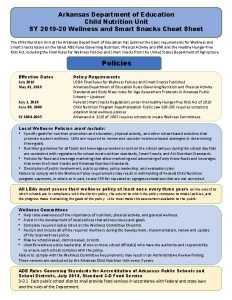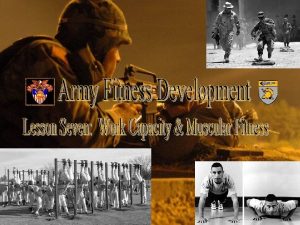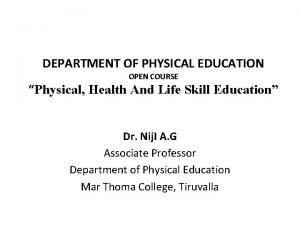Department of Physical Education Department of Physical Education

















- Slides: 17

Department of Physical Education

Department of Physical Education Lesson 2 Objectives • Describe and apply Periodization • Describe the Variables of Training (FITT) and apply to a physical training program • Describe ‘DIRT’ and apply to physical training • Describe the Principles of Exercise (PROVIRRBS) and apply to a physical training program

Department of Physical Education Periodization - the concept of “backplanning” and using a calendar to train for a specific training event. It is commonly used by elite and amateur athletes from virtually every sport.

Department of Physical Education Periodization Planning Year Quarter Month • • • Year – 12 months or 4 Quarters Quarter – 3 months or 12 weeks Month – 4 weeks or 28 Bouts Week – 1 week or 7 Bouts Bout – 1 workout Week Bout

Department of Physical Education Basic Principles of Periodization • Base – 4 -8 weeks – gradually increase volume at low intensities, incorporating a variety of exercises • Build – 4 -10 weeks - gradually increase progression of intensity and/or volume; incorporate exercise specificity and form • Peak (aka taper or pre competition) – 1 to 2 weeks immediately prior to event or competition; reduce volume & increase intensity; event specific movement • Recovery – 1 -3 weeks, reduced volume & intensity, rest, variety of exercises • Maintenance – exercising during a competition season to maintain gain made during the build or base phase.

Department of Physical Education Periodization Key Points (3) Peak (5) Maintenance (2) Build (4) Recovery (1) Base KEY POINTS - Avoid increasing both volume & intensity in any one week - Limit volume to 40 -60% during peak week; maintain high intensity - Some athletes may have many “peak” phases depending on seasons

Department of Physical Education FITT Acronym for the Variables of Training • Frequency - # of workouts per week • Intensity of effort - speed or resistance as a % of max effort • Time - duration (# of reps, distance, time) • Type - mode of exercise (run, weights, swim)

Department of Physical Education Periodization Planning Year Quarter Month FITT Week Bout

Department of Physical Education General FITT Application

Department of Physical Education DIRT Acronym drilling into the “I” in FITT • Duration - similar to “time” in FITT; total time (# of reps, distance, time) • Intensity of effort or terrain - speed or resistance as a of max effort; assessment of training surface (hill, flat, soft or hard surface) • Rest Time - active recovery or complete rest

Department of Physical Education DIRT Acronym drilling into the “I” in FITT D- 60 min. or 6 miles I- 5 min@50%HHR 35 min@80% HHR (2 MR Pace) 10 min@50%HHR 10 min Stretching Over rolling hills Paved Surface RT- 0 min

Department of Physical Education Periodization Planning Year Quarter Month Week DIRT Bout

Department of Physical Education PROVIRRBSAcronym for the Principles of Exercise Progression Overload Recovery Regularity Specificity Variety Realism Balance Individualism

Department of Physical Education PROVIRRBS • Progression: – start training at level appropriate for initial fitness assessment – gradually increase as your body adapts to training • Recovery: – optimal sleep; reduced activity – heal from stress of training (rebuilds tissue’ replenishes stored energy) • Overload: – train at levels that exceed normal demands (intensity and/or time) you place on your body Become a P-R-O

Department of Physical Education PROVIRRBS (cont) • Variety: – equipment, exercises & activities – avoids boredom, increases motivation (adherence), reduces risk of overuse injuries • Individualism: – know your capabilities/limitations – maintain strengths/work weaknesses • Regularity: – train often enough for your body to adapt

Department of Physical Education PROVIRRBS (cont) • Realism: – training plans and goals must make sense given time and resources available – failing hurts motivation and adherence • Balance: – components (health/skill) – push and pull movements at each joint – upper-body and lower-body • Specificity: – training demands must emphasize exact areas of desired improvement – movement velocity and patterns, muscle groups, energy systems, ranges of motion

Department of Physical Education Questions? Next Lesson: -Instructor Led Lab
 Similarities between health education and health promotion
Similarities between health education and health promotion Tiffany taylor georgia department of education
Tiffany taylor georgia department of education Ryan roemerman
Ryan roemerman Oklahoma alternative placement program
Oklahoma alternative placement program Sindh education and literacy department
Sindh education and literacy department Government of karnataka department of technical education
Government of karnataka department of technical education Ekurhuleni north district website
Ekurhuleni north district website 10 pillars of gauteng department of education
10 pillars of gauteng department of education Gde strategic goals
Gde strategic goals Manatee sso
Manatee sso Department of higher education and training
Department of higher education and training Ohio department of education science standards
Ohio department of education science standards Prime idoe
Prime idoe Deped order no 30 and 31 s 2019
Deped order no 30 and 31 s 2019 Department of education region 3
Department of education region 3 Fen ohen
Fen ohen Sample cigps in curriculum management
Sample cigps in curriculum management Child nutrition unit arkansas
Child nutrition unit arkansas

































